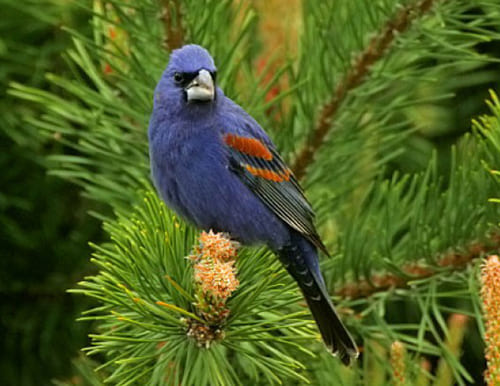The Blue Grosbeak is a heavyset songbird. They have large triangular bills that look like they cover the entire front part of their face.
These birds of shrubby habitats can be hard to spot unless you hear them singing.
Be sure to continue checking old-field or shrubby habitats, even if they seem to be absent. Many Blue Grosbeaks arrive pretty late into the summer, even well into July.
On this page
Identification
Adult male Blue Grosbeaks are rich, deep blue with a black-and-silver beak, chestnut wing bars, and a small black mask in front of the eyes. These birds are 5.9 to 6.3 inches (15 to 16 centimeters) long, weigh 0.9 to 1.1 ounces (26 to 31 grams), and have a wingspan of 11.0 inches (28 centimeters).
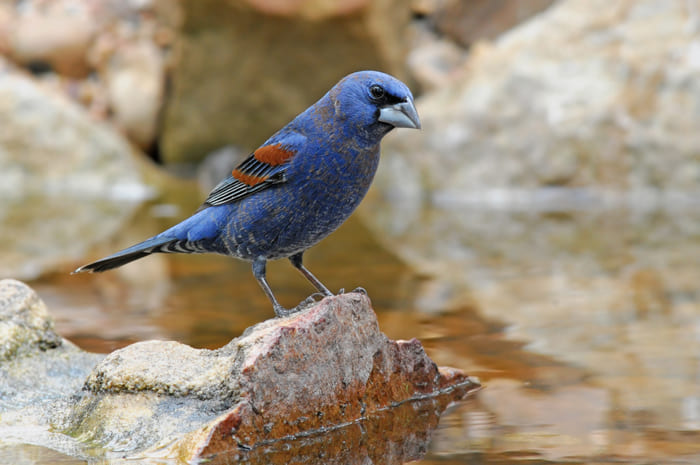
Female Blue Grosbeaks are mostly rich cinnamon-brown. The cinnamon-brown color is paler on the underparts and richer on the head.
Additionally, they have bluish tails. They’re the same weight and length and have the same wingspan as breeding males.
Also Included: Types of Blue Birds
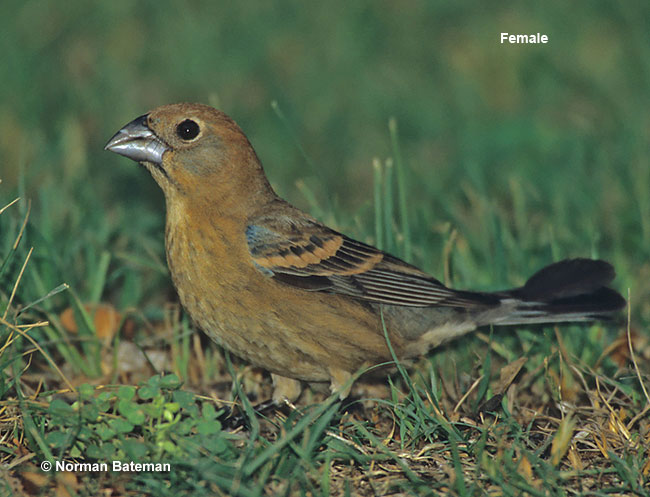
Both males and females have two wing bars. The lower wing bar is grayish to buffy, and the upper wing bar is chestnut. Juvenile Blue Grosbeaks tend to have chestnut wing bars and are a dark, rich chestnut brown overall.
Food
Blue Grosbeaks have a diet that mainly consists of insects. They especially love crickets and grasshoppers. Blue Grosbeaks will also consume cicadas, beetles, caterpillars, and treehoppers. They sometimes consume other invertebrates like snails.
A small portion of their diet consists of cultivated and wild grain seeds. The grains that they tend to eat are panicgrass seeds, bristlegrass seeds, wheat seeds, rice seeds, alfalfa seeds, oat seeds, and corn seeds.
They hover over foliage and catch food. They’ve also been known to look for insects on the ground and sit on a perch to catch flying insects. Blue Grosbeaks also feed insects to their young, but before they do so, they take off the wings, the legs, and the head.
Blue grosbeaks can visit backyard feeders anywhere within their range when migrating. So if you’re lucky enough to have one of these birds visit your yard, be sure to offer its favorite foods sunflower seed chips and millet!
Nesting and Eggs
Blue Grosbeaks create their nests in the lower portions of small shrubs, trees, briars, vines, and other vegetation. They’re often built in said foliage near roads or open areas.
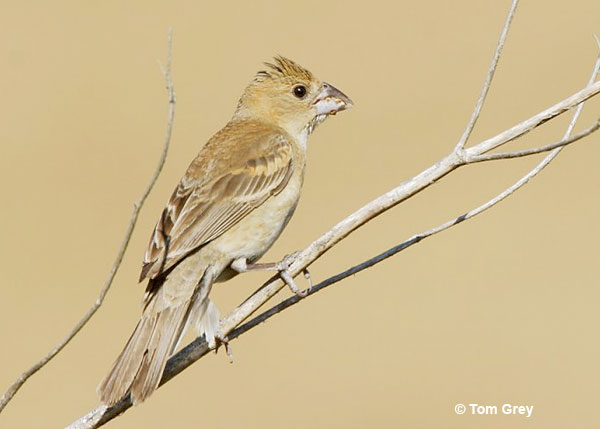
The female Blue Grosbeak will most likely do the majority of the building. However, male Blue Grosbeaks will occasionally create nests as well. The nest is cup-shaped and compact. It’s woven from bark strips, twigs, rootlets, rags, cotton, dead leaves, newspaper, snakeskin, string cellophane, and other materials.
The nest has an inner cup that measures around 2 inches deep and 2 to 3 inches wide; it’s often lined with fine grasses, hair, and rootlets.
- Clutch size is 3 to 5 eggs.
- Blue Grosbeaks will have 1 to 2 broods per breeding season.
- Egg length can be anywhere from 0.8 to 0.9 inches (1.9 to 2.4 centimeters).
- Egg width can be anywhere from 0.6 to 0.7 inches (1.6 to 1.7 centimeters).
- The incubation period is 12 to 13 days.
- The nestling period is 9 to 10 days.
- Eggs are white to pale blue, and on occasion, they’ll have brown spots.
Current Situation
Blue Grosbeaks are a widespread but uncommon bird that can be found in the southern portions of the U.S. They have a stable population that has increased every year by 0.7% between the late 1960s and 2019.
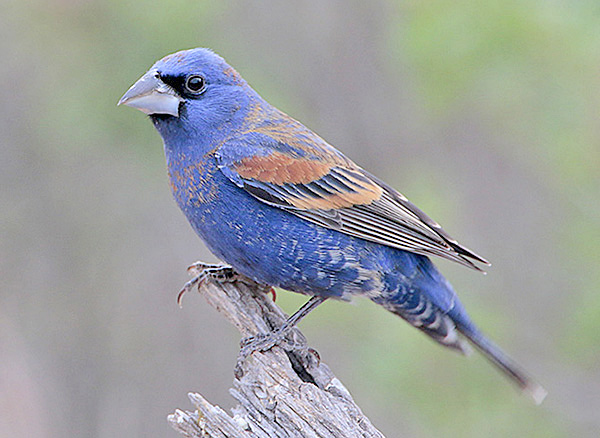
Photograph © Greg Lavaty.
The estimated breeding population for this species is 35 million.
Their population grew in the late 1800s and early 1900s. It’s theorized that this is because of humans clearing out some forests.
Blue Grosbeaks have great densities in their habitats; it’s about 80 breeding male Blue Grosbeaks per square mile. It’s yet to be determined if the effects of deforestation and agriculture in their wintering areas are negatively affecting their population.
Facts
- The blue color we see on Blue Grosbeaks is not because of pigment. It’s actually a function of the way the light hits its feathers.
- The Blue Grosbeaks’ closest relative is the Lazuli Bunting. The Lazuli Bunting is a finch that eats seeds and lives in the U.S. It was discovered that it’s the Blue Grosbeaks’ closest relative via genetic testing. However, you’re unlikely to see these birds together because their ranges barely overlap. The Lazuli Bunting is found in the west, and the Blue Grosbeak is found in the south. However, both birds are bright blue, which is rare in the animal world.
- Male Blue Grosbeaks are the only ones to sing, and their songs get longer as the birds get older.
- Blue Grosbeaks can live to be over 10 years old! These colorful birds have populations that are expanding northward as forests continue to be cleared. So if you’re fortunate enough to see a Blue Grosbeak year after year, there’s a good chance that it’s the same one.
Similar Species
Blue Grosbeaks have features that are similar to other birds. Here are some similar species:
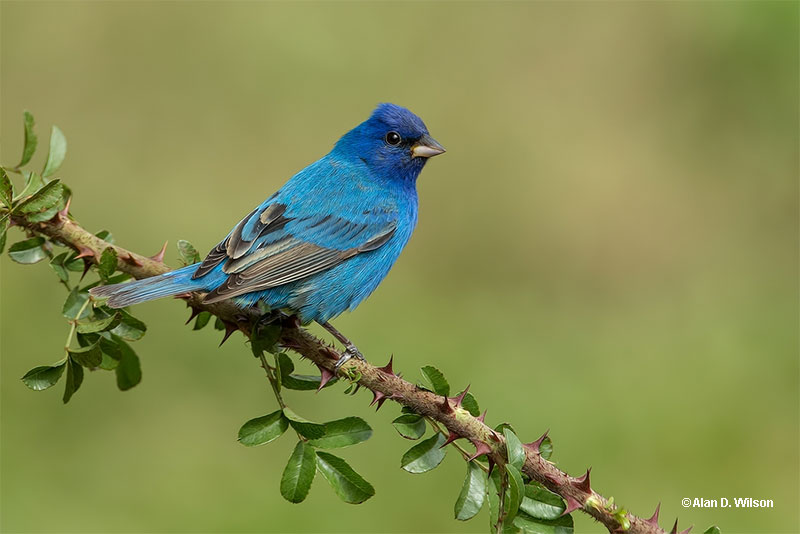
Indigo Bunting © Alan D. Wilson
Blue Grosbeaks are larger than Indigo Buntings; they have larger, rounded heads and much larger bills.
They also have apparent wing bars that Indigo Bunting does not have.
Female and immature Indigo Buntings also have faint streaks on their underparts, unlike juvenile and female Blue Grosbeaks that have unstreaked, darker bellies.
Read more: Blue Grosbeak vs Indigo Bunting – What are the differences?
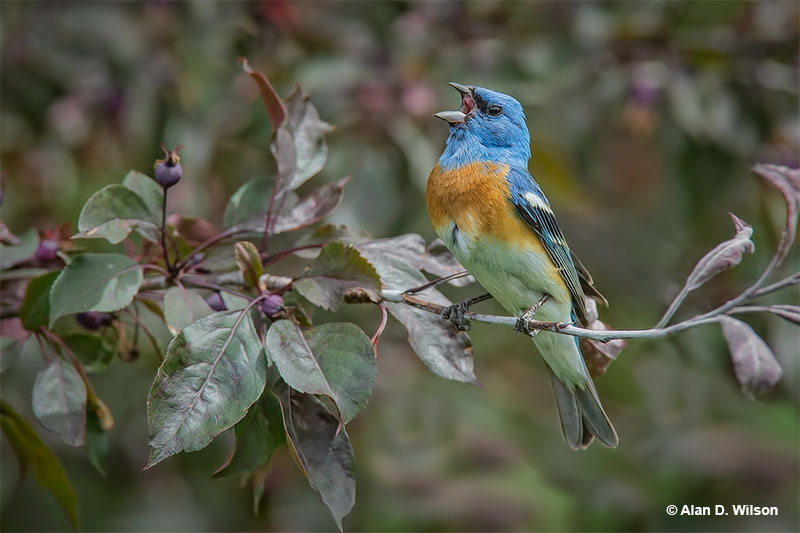
Lazuli Bunting © Alan D. Wilson
Blue Grosbeaks are larger than Lazuli Buntings; they have much larger bills.
Breeding male Lazuli Buntings have orange breasts with sky-blue bodies. Adult male Blue Grosbeaks have rusty wing bars and are deep blue overall.
Female Lazuli Buntings have paler bellies and buffy wing bars, unlike female Blue Grosbeaks, which have darker bellies and brown wing bars.
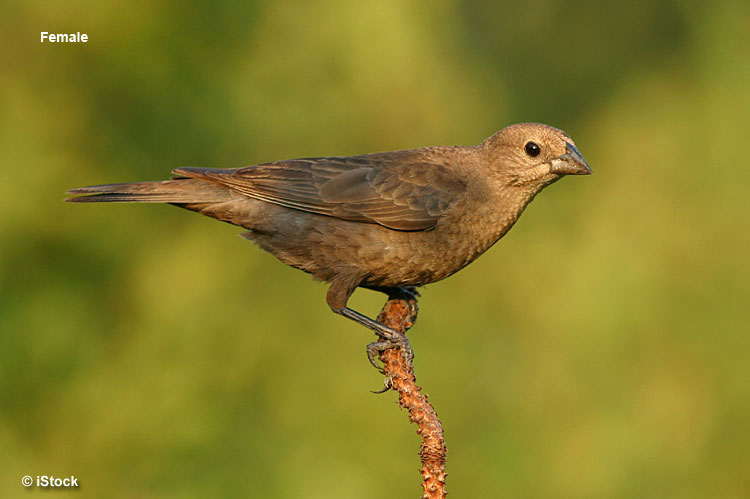
Female Brown-headed Cowbird
Immature and female Blue Grosbeaks are rusty pale below and have brown wing bars.
Female Brown-headed Cowbirds are brownish and paler below and lack wing bars.
Female Cowbirds are known for their habit of laying their eggs in other’s nests.
Frequently Asked Questions
Are Blue Grosbeaks common?
No, Blue Grosbeaks are not common. They’re a widespread bird but are uncommon across the southern portions of the U.S. Their estimated global breeding population is 35 million, and they’re rated 8 out of 20, which means they’re a species of low concern. Blue Grosbeaks have the greatest densities in mixed loblolly-shortleaf pine forests in eastern Texas and mature longleaf pine forests of Florida. To put this into perspective for you, it’s about 80 breeding male Blue Grosbeaks per square mile.
What’s the range of a Blue Grosbeak?
Blue Grosbeaks are long-distance migrants. Most of the birds that nest in the eastern portions of the U.S. probably fly to their wintering grounds across the Caribbean. Western individuals most likely migrate over land.
What does a female Blue Grosbeak look like?
Female Blue Grosbeaks are mostly rich cinnamon-brown. The cinnamon-brown color is paler on the underparts and richer on the head. Additionally, they have bluish tails. They’re the same weight and length and have the same wingspan as breed males.

